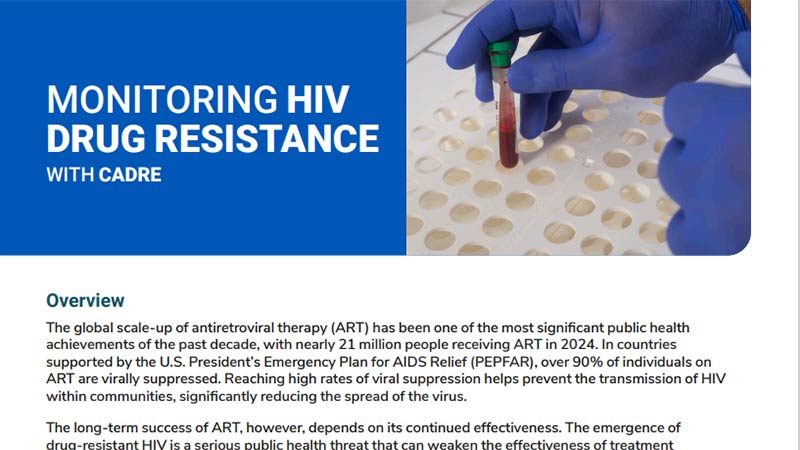At a glance
- What you need to know about monitoring HIV drug resistance and how it can be used.
- The fact sheet also shares details on how CDC leads surveillance of HIV drug resistance with Cyclical Acquired HIV Drug Resistance Surveillance (CADRE).
508 text
Overview
The global scale-up of antiretroviral therapy (ART) has been one of the most significant public health achievements of the past decade, with nearly 21 million people receiving ART in 2024. In countries supported by the U.S. President’s Emergency Plan for AIDS Relief (PEPFAR), over 90% of individuals on ART are virally suppressed. Reaching high rates of viral suppression helps prevent the transmission of HIV within communities, significantly reducing the spread of the virus.
The long-term success of ART, however, depends on its continued effectiveness. The emergence of drug-resistant HIV is a serious public health threat that can weaken the effectiveness of treatment options, hinder efforts to control HIV, and increase the risk of severe disease and death. With increased globalization and travel, the rise and spread of drug-resistant HIV anywhere in the world poses a direct threat to the health and safety of Americans. Proactively monitoring drug resistance trends overseas provides an early warning system against the emergence of new, harder-to-treat forms of HIV that could spread to the U.S.
HIV Drug Resistance with CADRE
CDC leads global efforts to monitor HIV drug resistance, focusing particularly on dolutegravir (DTG)-based regimens, which make up 92% of ART provided through PEPFAR.
What is CADRE?
CDC uses the Cyclical Acquired HIV Drug Resistance Surveillance (CADRE), a laboratory-based HIV drug resistance monitoring process. CADRE uses existing laboratory networks to conduct genetic testing on leftover viral load specimens collected for patient care.
CDC strengthens surveillance of HIV drug resistance in PEPFAR-supported countries by:
- guiding laboratories in the procurement of equipment and supplies.
- providing training and technical support.
- ensuring quality assurance.
Data from CADRE can be used to:
- Measure resistance to DTG and other antiretroviral drugs in different populations and settings.
- Identify risk factors that increase the likelihood of developing resistance.
- Inform treatment choices when resistance is detected.
- Monitor performance of HIV treatment programs in achieving viral suppression and if gaps in adherence, drug supply, or service delivery contribute to resistance.
- Provide evidence to inform national guidelines, optimize ART regimens, and prioritize resource allocation for HIV control and prevention.
Informing Global Guidelines
CADRE fills an important gap in monitoring HIV drug resistance in settings where it is not feasible to conduct patient-level drug resistance testing. The routine collection and analysis of specimens through CADRE will also allow for cost-effective and continuous monitoring of DTG resistance in PEPFAR programs. With CADRE, CDC seeks to create a stronger surveillance database for in-depth analysis of factors contributing to HIV drug resistance. This will offer crucial data to guide treatment choices for the large number of patients struggling with HIV on DTG-based regimens, preventing severe disease and virus transmission.
CADRE Implementation
CDC is building capacity for surveillance, strengthening laboratories, and leading the implementation of CADRE in 19countries, with support from PEPFAR. Laboratory and clinical surveys show that most patients on DTG-based treatments have low levels of drug resistance, meaning these regimens are still effective. PEPFAR studies found that 3.9% to 19.7% of patients who had treatment failure in low- and middle-income countries developed resistance to DTG, suggesting that a change in treatment would not be beneficial. When treatment fails, it is often because patients did not complete their full treatment; therefore, providing support and education should be the focus.
What's Next for CADRE?
CADRE will provide a unique opportunity to analyze DTG resistance across a substantial number of cases and countries. These insights will inform global and national treatment guidelines, ensuring that HIV programs remain responsive and effective. This proactive, data-driven approach minimizes the risk of costly treatment failures in the U.S. and abroad, protects substantial U.S. investments in HIV treatment, and ensures continued progress against HIV and drug resistance.

